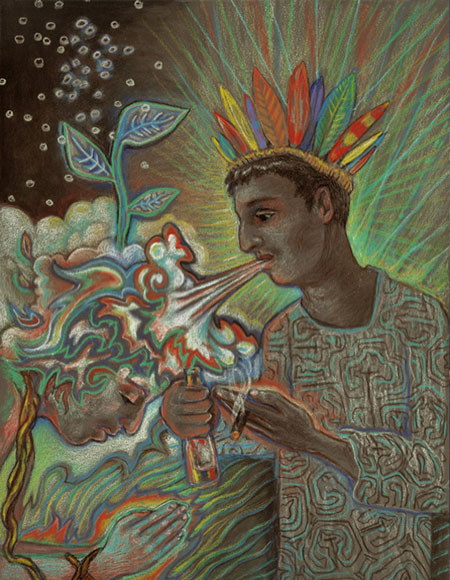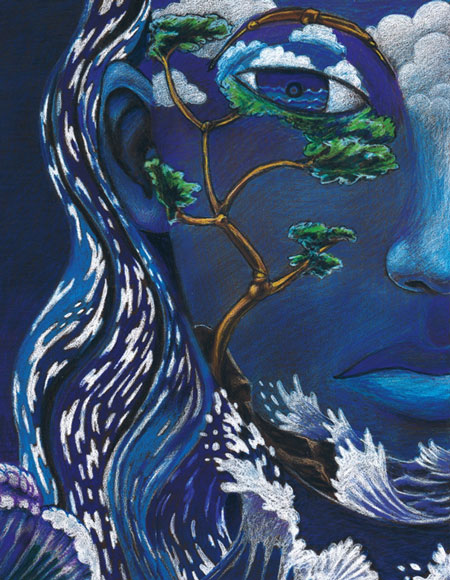- Queering Psychedelics: An Introduction - August 7, 2024
- Introduction to Women and Psychedelics - July 26, 2024
- Eight Frequently Asked Questions About Ayahuasca Globalization - February 13, 2024
This article is the second in a series on the psychology of ayahuasca. Click here to read the first piece: The Effects of Ayahuasca on the Ego
Ayahuasca has been called the teacher of all teachers, and its lessons are respected by those who use it in every format and style. I have been drinking ayahuasca for 19 years and have also undertaken formal research into the psychological terrain of ayahuasca’s effects upon individuals and society. This has offered me a range of insights into how people have worked with ayahuasca to achieve psychological healing and spiritual grace in their lives. In this article, I share what I think are some of the most useful insights for how to safely work with ayahuasca to develop psychological and spiritual well-being. You’ll also learn about important obstacles that may arise on the path of psycho-spiritual flourishing.
Ayahuasca 101
There are three stages to the experience of ayahuasca: 1. preparation 2. the ritual or experience of drinking the ayahuasca, and 3. the aftermath, which includes integration. Each stage is of importance to the experience, and each can create problems if not approached carefully.
First, the preparation requires some form of screening. This preliminary practice is dispensed with often in places in South America by unscrupulous practitioners who are motivated to increase sales, but it is known that people with psychotic tendencies or with severe mental illness are bad candidates; the insecurity of their egos can make ayahuasca problematic, and unmoor more fragile senses of self. Being well rested and in good health can help in the endurance of the stronger effects, although ayahuasca is often drunk by sick people seeking healing.
The Ayahuasca Diet
As regards diets and preparation, it is important to follow the direction of the one providing the medicine; if they are trustworthy and you believe them to have your best interests at heart, and if they are experienced; you are putting yourself in their hands and should follow their recommendations. If you do not trust or respect them, then you should not be drinking with them. The church of Santo Daime has a 7-day period, 3 days before and 3 days after, in which sex, alcohol and drugs (except marijuana) are proscribed.
Indigenous shamans may engage in diets that last for years, and may prescribe diets free from such dietary items as salt, sugar, spices, pork, and caffeine in addition to social contact and sexual activity, allowing only a limited diet of oil-free root vegetables, rice, and fish. This diet has been altered as more Northerners come to drink, so that the social isolation has been eliminated and we see the invention of “social diets,” in which only the sexual and food prohibitions are kept, and the person continues their normal daily activities.
Briefly, there are few indications that not following a diet, or even taking many of the medicines that are warned against, will have physically harmful consequences for ayahuasca drinkers; however, resistance to these dietary and other restrictions puts one at odds with the instructions of the purveyors, creating an oppositional start to an experience that already has the potential to destabilize one’s worldview. If the opposition is strong, it is best that you not drink with that group or shaman; it reveals a lack of respect that could snowball during the ceremony and result in a negative outcome without any real chemical harm, but negatively altering the experience simply by manifesting disrespect and resistance.
Choose Your Ayahuasca Ceremony Wisely
Not only are participants in need of screening, but so also are those who are providing the drink, who must have known reputations for ethical behavior and be trustworthy providers who work within a known protocol. Agreeing to drink with strangers about whom little is known is a condition that may lead to tragedy. Reports of sexual molestation and inappropriate behavior have increased as the culture of Northern spiritual seekers meets mestizo and indigenous culture in the Amazon Rainforest, each group with their own cultural presuppositions.
Regarding the shaman or curandero as a doctor or psychiatrist in the Western model, or even as a priest or pastor in a religious model, does not offer a useful template for the role of the shaman in his community, and can blind participants to the breadth of behaviors that may transpire. It is best to wait to drink until mutual trust is established. In the United States, purveyors tend to be more cautious because of the risk of exposure and possible legal action due to the illegal nature of most ayahuasca activity in the States. It is good to know what is in the brew one is consuming, and to avoid mixtures that contain Brugmansia (toé) or tobacco—which can, in excess, be toxic or even fatal—unless one has worked with the provider and has a trusting relationship after several experiences with them.
The Ayahuasca Experience: What to Expect
Several attempts have been made to categorize ayahuasca experiences, the most extensive of which is Benny Shanon’s The Antipodes of the Mind, 1 a phenomenological examination of the themes present in ayahuasca visions and understandings. Shanon believes ayahuasca visions can’t be forced into archetypal scenarios. Other writers emphasize the appearance of archetypes and other elements of the classical subconscious.
Michael Harner2 came up with five common themes in South American ayahuasca shamanism, comprising 1. the soul separating from the physical body, 2., visions of jaguars and snakes, 3., visions of demons and deities, 4., visions of distant persons, cities, and landscapes, and 5., the sensation of seeing the detailed enactment of recent unsolved crimes. For Northerners, messages and symbols can appear with very personal content relating to experiences in the past that are unresolved, or visions that contain symbolic messages that may be understood immediately or that may take time and consultation to understand.

Artwork by Clancy Cavnar
One element of the ayahuasca experience that is often most feared, and may then transform into something most desired, is the purge. This can be either through vomiting or defecating, and often both. Bad ideas, difficult patterns, evil spirits, and other entities are believed by some to be released in the purge. In some indigenous communities, the purge is the main effect sought after, while Northerners seek more after visual effects. The purge is theorized to be mostly instigated by the vine, while the visions are intensified when more DMT-containing Psychotria viridis or Diplopterys cabrerana is added.
Purging is, in essence, cleaning, and it is said that the more dirt (addictions, compulsions, envy, negative judgments, etc.) one has, the more purging will be necessary. Shamans may purge the bad elements of their patients on occasion. Purging soon after drinking will lessen the effect of the ayahuasca, but purging later can accentuate the effects, often in a positive way. There are many people who fear the purge and refuse to drink for this reason, but those who have purged in a ritual come to value the process as transformative and purifying. Nausea is ordinarily short-lived and disappears once the purge is complete. Likewise with diarrhea and bowel movements; though less convenient than vomiting, they have the purpose to clean deep inside the body, and cooperation is mandatory. Rituals of symbolic purification abound in many cultures, but ayahuasca provides an actual cleaning of the alimentary system, the main way by which humans ingest and excrete. Vomiting in a prone position can result in aspiration of the vomit and possible suffocation. This is one danger that is rare but real, and a safe practice is to keep all participants in view during the ritual, so that none is left unattended, especially if they are powerfully affected.
The experience is very different for everyone, from mild alterations to experiences of dying, changing into animals, entering multi-dimensional worlds, exploring past trauma, speaking with invisible beings, having deep and joyous, or dark and troubling, insights, adoption of new identities and understandings about one’s role in life and love for humanity, seeing the dead, and a variety of other non-ordinary experiences that often have a teaching quality. The content of the experience will, to some extent, be affected by the environment, the strength and quality of the ayahuasca, and the people who are present; not only the shaman or leader, but other participants as well, especially in regard to their appropriateness for the experience and the sincerity with which they seek.
Resistance is Futile
During the ceremony, resistance is futile, and will result in a more difficult experience. Surrender is recommended, and focus on the breath and relaxing the body can help the difficult experience pass more easily. Remembering that the effects are transient, and that the medicine is not lethal can also help. The more one turns toward that which one previously avoided, the quicker the transformation from resistance to acknowledgment and the ability to move on. Music guides most ayahuasca ceremonies, and this can also be useful in helping to move out of uncomfortable places. Icaros are designed to manipulate energy, and other music used in rituals is credited with having the power to alter one’s state or infuse the listener with spiritual understanding. Ayahuasca also seems to inspire musical talent, as well as other artistic expression.

Artwork by Clancy Cavnar
Some Less Common Effects of Ayahuasca
Unusual effects are sometimes seen. For example, sometimes a person feels nothing; that person may feel something if they drink again, or they may be a person who, for whatever reason, does not ever feel the effects. Sometimes, instead of mood elevation, a person will experience sadness or symptoms of depression. In this case, some advise ingesting more ayahuasca to work past the block, and some will advise avoiding the substance. In indigenous traditions, this is when a shaman or curandero will be called to evaluate the situation and make a recommendation. The view of the Santo Daime group is usually to drink more daime until the sadness passes. It is important that symptoms do not increase, and assessments for suicidality should be made in anyone who is having an especially hard time after drinking ayahuasca. Sometimes facing one’s dark side can be depressing, but it is a transitory state; sometimes, a deep depression can set in that needs clinical attention. Non-fanatical estimation should also be made of the condition of the suffering person, as no blanket rule is true for all people, and it may be that ayahuasca is inappropriate for certain people who have no psychosis or mental disorder, but in whom it inspires depression.
After The Experience: Integration
After the experience, there is the recognition that, though the visions have faded, the ayahuasca continues to work. In some traditions, the diet continues for several weeks after the last ayahuasca has been consumed, and in others, such as the Santo Daime, a three-day period, similar to the one that preceded the ritual, with no sex, drugs or alcohol, is recommended. After the experience, people can feel very open and sensitive, and will feel better if they can plan to rest and have minimal activity in the hours and days immediately after the ayahuasca ritual has ended.
Insights can be integrated, treasured, or ignored. Yet, some people may devalue the experience and discount the meanings uncovered, so that skepticism and doubt can undo some of the benefits. Others may try adopting indigenous belief systems to find ways to make sense of their experiences in this light. Ayahuasca may reveal many things, but putting that knowledge to use is up to each participant, and even mild doses can incite dramatic change in someone who is ready to put into practice the lessons they are taught.
Currently, integration groups and services have been gaining popularity as people return from the rainforest or from a local workshop with questions about how to implement and understand the things they have learned in ayahuasca sessions. A growing need has created a market for experienced facilitators and therapists to help guide practitioners who do not have an understanding community to rely on for support outside of their ayahuasca-using circles, which may meet rarely or only when a shaman is in town, and whose members may only have this activity in common and may travel from distances for the ceremony. Other groups may consist of people from various places around the world who have met in South or Central America for an intense retreat, then dispersed home.
The creation of community based on interest is a phenomenon that has been helped by the use of the Internet, and at least one center is providing Skype counseling and check-ins with therapists associated with the center to participants after they leave so they can maintain connections with people who understand what they might be going through. Integration services are being offered in a variety of contexts, from circles of peers who meet to discuss their various psychedelic experiences, to groups attached to a center or leader, to groups led by licensed therapists, and one-on-one consultations with people whose experience ranges from participation in Alcoholics Anonymous to licensed medical doctors, psychologists, and nurses. This specialty arises from the growing desire of clients to see non-pathologizing interpretations of their substance use in a self-exploratory or healing context. The Bay Area, in California, USA, is rich in people with this orientation, but such therapists are more rare in other parts of the country and the world, so the benefits of Skype consultation becomes apparent; people who meet at retreats from all over the world maintain contact with each other through Facebook groups and with the center through social media, local experienced contacts, and long-distance Skype counseling. The Temple of the Way of Light, near Iquitos, Peru, is at the vanguard in this respect.
Outside of groups or counseling, activities after a ceremony should be low-key and gentle. Some kind of diet will most likely still be in effect and the medicine will remain in the system for an estimated 2 weeks, after which the effects will decline. Of course, insights and visions can be remembered, but the anti-depressant effect and expanded state will diminish. One way of augmenting the processing is to write, paint, or make other creative expressions. Musical expression is another hallmark of ayahuasca use, and many discover the ability to sing or play an instrument after drinking. An overall appreciation for art and beauty stand out for many people in the days following a ceremony.

Gratitude and Other Gifts of Ayahuasca
I would like to point out the stimulation of feelings of gratitude that ayahuasca can produce. This gratitude can manifest, among many ways, as a commitment to saving the natural environment in which ayahuasca grows; to helping heal the sick or guiding the lost, with a new recognition of the brotherhood of all people; or to helping spread the news of ayahuasca to people and places it remains unknown to, with the hope that others may benefit from its powers. Although ayahuasca has existed for centuries, it is only now that Northerners are aware of it and thirsting for its personally transformative effects. I would like to express my own gratitude for its effect on my life, and hope I can repay the gift I have received.
Ayahuasca, perhaps more than other psychedelics, has a persona, a teaching presence that is able to root out and display the most intimate secrets, desires, and wounds that have been hidden from the ego. This inspires reverence. This incredible intimacy and vast knowledge—in which a full grasp of our unlimited selves existing outside our normal perception becomes magically apparent, flooding us with sensations and emotions, clearing the way for peace and silence—inspires gratitude and indebtedness. Humility is a byproduct of gratitude and together they may be the greatest reward, the antidote to the bloated ego that consumes to reinforce its identity; how remarkable that this is the result of drinking a beverage!
References
- Benny Shanon, Antipodes of the Mind: Charting the Phenomenology of the Ayahuasca Experience (Oxford, UK: Oxford University Press, 2002) ↩
- Michael Harner (1973). “Common Themes in South American Indian Yagé Experiences, In Hallucinogens and shamanism, ed. Michael J. Harner (New York City, NY: Oxford University Press, 1973), 155–175. ↩
Take a minute to browse our stock:
Did you enjoy reading this article?
Please support Chacruna's work by donating to us. We are an independent organization and we offer free education and advocacy for psychedelic plant medicines. We are a team of dedicated volunteers!
Can you help Chacruna advance cultural understanding around these substances?













